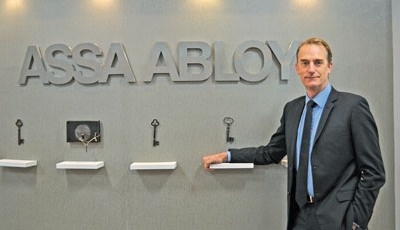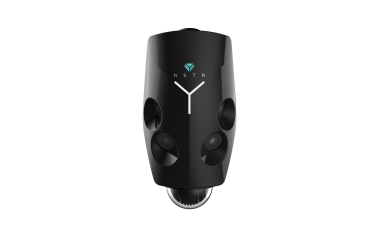Enlarging an Access Control System with Wireless
The task of planning room usage within a building or factory includes forming secure areas for IT, development departments, archives and other specific industry-related areas. Thes...

The task of planning room usage within a building or factory includes forming secure areas for IT, development departments, archives and other specific industry-related areas. These often change over time and may exceed the capacity of the originally installed access control system. GIT-SECURITY.com spoke with Chris Bone, Vice President Access Control EMEA Assa Abloy, about one of the expansion options.
Mr. Bone, Assa Abloy is just about to present a number of new features for "Aperio", a technology enabling mechanical locks to be wirelessly linked to access control systems that usually only control a selected number of important doors. Aperio has been around for quite a while now, but could you give us a brief introduction for those of our readers who are not yet familiar with it?
Chris Bone: It is true that Aperio has been around for some time, but the product range has recently been expanded dramatically to address a far broader market, something we are very excited about. In brief, the solution is a broad range of either on-line or off-line wireless "electronic cylinder, escutcheon and lock" products designed for integration into third party access control systems. The market it addresses is for simple, cost-effective expansion of new or existing access control systems.
What does it technically take to install such a system in a building?
Chris Bone: It takes similar skills as for traditional access control systems, but it is far quicker and cheaper as there is no need for wiring at the door or down the wall.
What is the difference between your system and those of your competitors on the market?
Chris Bone: There are two main differences. Firstly we have leveraged the global presence and capabilities of Assa Abloy to offer the broadest range of products in the market. Secondly as Aperio is not a stand-alone product the customers get the benefit of integration into their new or existing access control system without the need to manage and monitor separate systems.
What made the development of such a system so difficult?
Chris Bone: Two main issues. Developing the complex electromechanical ecosystem and balancing the needs of low power consumption against functionality whilst ensuring the security of the system is maintained and secondly ensuring there is an Aperio solution available in the large variety of global hardware profiles our customers would expect. This has all taken time and considerable effort but we have achieved this and are now pushing forward with even more solutions.
One of the new additions to Aperio is a hub covering eight doors at a time, instead of having one hub for each door. What other
features are there?
Chris Bone: That is a big question as new features and products are being added on an almost weekly basis now. Just a few recent examples: in addition to the new hub covering up to eight doors we have also expanded the wireless range to 25 meters for a typical office environment. We recently released a new Wiegand hub which allows anyone experienced with access control to install Aperio into an access control system without the need to do integration development work. We also have a new IP54 and security rated escutcheon solution, and we have added new RFID technologies to the range.
Who are your direct customers? Are they rather system integrators or OEMs? And could you tell us what advantages both they and their customers have when they work with it?
Chris Bone: Our direct customers are a combination of both OEM's and their own SI channels. As Aperio is not a standalone system the advantage for both OEM's and SI's and most importantly their end user customers is twofold; firstly, they have an efficient technology that allows them to cost effectively add additional access control doors to their facility without the need to change or add cards; secondly, they retain the familiar power and features of their existing access control central software so they have a single system for card management, reporting and integration into additional third party items such as CCTV or fire. Aperio is developed to be part and complement the existing EAC solution of the OEM.
The system is distributed world-wide under the Assa Abloy brand name - which is not typical for your Company with it's huge amount of brands. What is the reason for choosing this strategy?
Chris Bone: Aperio is what we refer to as a group technology brand in Assa Abloy, and whilst globally there are many different hardware profiles that it is included in, for the customers the functionality and features remain generally the same - hence the strategy of placing the Aperio technology under the globally recognized brand of Assa Abloy.
How do you deal with the problem of every country or region having their own cylinder standards?
Chris Bone: This is one of the core strengths of Assa Abloy. We are able to leverage the local manufacturing and development capabilities to ensure we can supply Aperio in almost every cylinder and other hardware profile available globally. This is a real benefit for our customers as they have the assurance of choosing one solution that will work for them anywhere and they can leave the issue of local standards to us.
The system can handle Mifare, and HID's Iclass - what about other card technologies?
Chris Bone: We have recently also added Mifare Classic and Plus and Mifare Desfire and in the very near future we will be adding other smart card technologies such as Picopass, Rijkspas and Legic Advant. And one of the most exciting developments planned for release in early 2012 is 125 Khz (Low Frequency) for our on-line Aperio solution which will allow thousands of customers who have invested in 125 Khz to add Aperio devices to their facilities without having to replace expensive access control cards and readers or to have separate systems.
What market volume are we talking about - do you have estimates of the world-wide demand?
Chris Bone: One could answer this by saying how long is a piece of string as this is impossible to estimate with real accuracy. However our own estimates are that less than 5 % of doors in a commercial building typically have wired access control installed. Our plan with Aperio is to provide an economic and wireless solution to expand this in addition to wired solutions of another 20 %, hence we are ultimately expecting a market of millions of doors. But we realize of course that building market confidence and demand will take time so we anticipate a short to medium term demand in the hundreds of thousands of units globally.
What are your plans for 2012 and beyond regarding Aperio?
Chris Bone: The plans for Aperio are very busy in the coming years. We will continue to grow and expand the product range by adding new technologies as well as new hardware profiles and architectural ranges and some innovative new locking solutions. In addition we recognize that supporting our customers is critical to success so we will also continue to invest in new sales and marketing support as well as training and technical support. All in all, we feel sure that we will be bringing many exciting new developments to the market with Aperio in 2012 and beyond.












